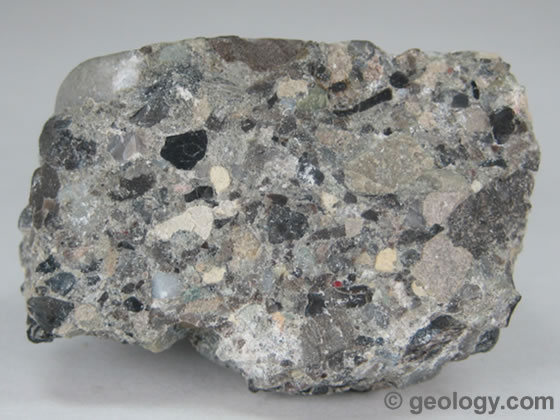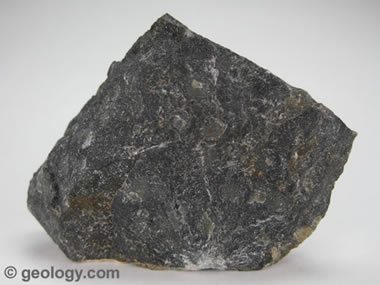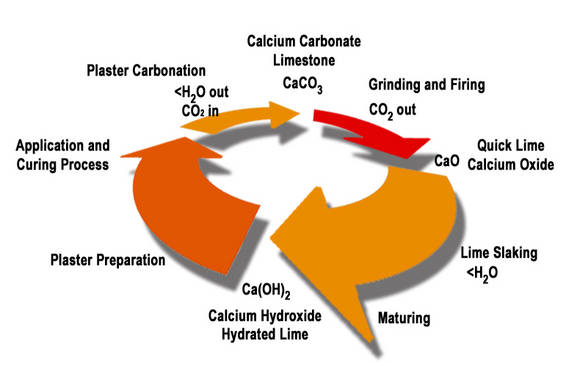A consideration of the natural processes leading to soil formation leads to a discussion of the factors which affectthe rate of reaction, including catalysts. The importance of limestone products is considered and the effect of pH on the availability of ions for plant growth investigated.
-know that rocks may be classified as sedimentary, igneous or metamorphic
Igneous is formed by melting rocks. Then cooling them. As they cool they make crystals. Sedimentary is built up from particles cemented together. Metamorphic is fromed by the action of pressure on rocks.
-know that geological time scales are very long compared to human lifetimes
To make a sedimentary rock it takes a lot of heat, pressure and millions of years.
-know that weathering of rocks is the result of both physical and chemical changes and that soil is formed from both rocks and organic material
Physical weathering includes rain, wind, waves and freeze-thaw. Chemical changes comes from acid rain or the action of water.
-be able to describe at least one example in each case of physical, biological and chemical weathering of rock
Biological weathering may come from animals digging or roots growing in rock. Physical may also include exfoliation.
-understand the role of limestone in the extraction of iron
Crushed limestone is used in extracting iron from it's ore - it's a competion reaction.
-know that weathering of rock releases salts into the soil which plants need for growth
Salts released include -calcium, (Nitrates) Phosphates, potassium
-understand the importance of controlling soil acidity
plants can't grow if the soil is too acidic. Acid rain may change the soil. Add lime to soil to reduce acidity
-understand that concentration, temperature and surface area are factors which affect the speeds of chemical reactions
High concentration gives faster reactions, as does high temperature and larger surface
-be able to describe tests for oxygen, hydrogen and carbon dioxide
Oxygen - glowing splint relights, Hydrogen - a burning splint gives a pop - CO2 - limewater turns milky
-be able to interpret data from reaction rate experiments
Slope of a graph is greater if the rate of reaction is greater.
-understand the factors affecting reaction rate in terms of the frequency of reactive collision between particles
Rate of reaction depends on how many successful collisions there are in a unit time. Temperature increase rate because the molecules collide more often and with more energy.
Types of Weathering:
Rocks are weathered into soil, by physical, biological, or chemical weathering. (Exfoliation is another type of weathering but I don't think you don't have to know this one in science, only in geography)
Physical
Physical weathering is when a rock is broken into fragments, but not chemically changed. An example of physical weathering is "freeze-thaw" weathering. When temperature changes, water that goes into cracks in the rock freezes and because water expands when it freezes, it makes the cracks widen. This causes the rock to weaken physically and start to erode.
Chemical
Chemical weathering, is when a rock is broken down because its chemical composition is changed. A common example of this is when rocks are eroded by acid rain (carbonic acid).
Biological Weathering
Biological weathering is when roots of plants, like trees, grows through large rocks and break them into pieces. Usually biological weathering starts when a seed gets into the crack of a rock and starts growing. The seed may get into the rock because of the wind carring the seed, animals carrying them and ejesting them, or a tree near the rock can start growing into the rock.
Types of Rocks
Rocks are classified into three classes, igneous, metamorphic, and sedimentary rock.
Sedimentary Rocks
Sedimentary rocks are rocks that from when sediment is packed together under ground under heat and pressure, over the course of millions of years. An example of a sedimentary rock is limestone, one way that these sediments form are when sea creatures die and they slowly get covered in layers of rocks, over time they become limestone because of the minerals they contained in their bones.

Igneous Rocks
Igneous rock is formed from magma (molten rock), undergound it is trapped in small pockets they then cool slowly and recrystallizes again. Above ground when there is a volcanic eruption lava cools much quicker and forms smaller crystals because they cool too quickly, if they cool slower they can make more crystals. The most common example of igneous rock, is granite. It forms in the hot soft layer of rock below the lithosphere, which is the outer part of the world.
Metamorphic Rocks
Metamorphic rock is made from a combination of the processes that make igneous and sedimentary rock. It is formed when grains of different rocks are pushed together, circulating water speeds up the reaction, and the pieces of rock melt and recrystalize. Then pressure forces the rocks together to make larger grains, or if pressure mainly omes from two sides, the rocks becomes layered. Some common examples of a metamorphic rock are marble, and shale.

The Rock Cycle Diagram:

How limestone is formed:
Creatures from the sea often have shells and skeletons made up of calcium carbonate. Over millions of year pressure turns layers of shell and bones fragments into limestone rock. After other millions of years powerful forces raise the seabed and forms montains. This is why limestone is found inland.

Uses:
Crushed limestone is used for:
- extracting iron from iron ore
- making sodium carbonate
- making materials for road building
- making concrete
- Roofing Granules to be used as a roof layer to add a heat weather resisting coat
When limestone is heated it forms quicklime;
Quicklime is used for:
- making steel from iron
- neutralizing acidity in the soil
- industrial drying agent (taking humidity out of chemicals)
- Used to disolve lignin present in paper
- Used in bleaching
- Used to blind people suring early naval warfare
- Used to desulphurise harmful gases
- Used to reduce the smell of decompsing bodies at cemetaries and in other experiments
- It is a dehydrating agent
- Used in paints
- used in Pottery
- Used in food industries
- Used as Greek Fire, when it hit water it produced heat which was used to ignite a fuel
- Used to make soap when it was mixed with sand
When limestone is heated with clay it forms cement.
Cement is:
- used to make concrete
When crushed limestone is grinded it becomes powdered limestone.
Powdered limestone:
- neutralize acidity in soil
- neutralize acidity in water
- neutralize sulphur dioxide in flue gases from power stations
- making glass
When water is added to quicklime it forms Slaked lime.
Slaked lime produces/makes/does:
- neutralizes acidity in soil in lakes affected by acid rain.
- purifying water
- making mortar, plaster and whitewash
- pottery
- chemicals
- dyes
- solvents
- paints
- medicine
- Added to sea water to reduce the amount of CO2 that it gives of
- In hair removal creams
- Manufacturing additive oils
- Preparing dry mixes of paint
- In the manufacuting of pesticides
- Used in processing water for sodas and alchohol